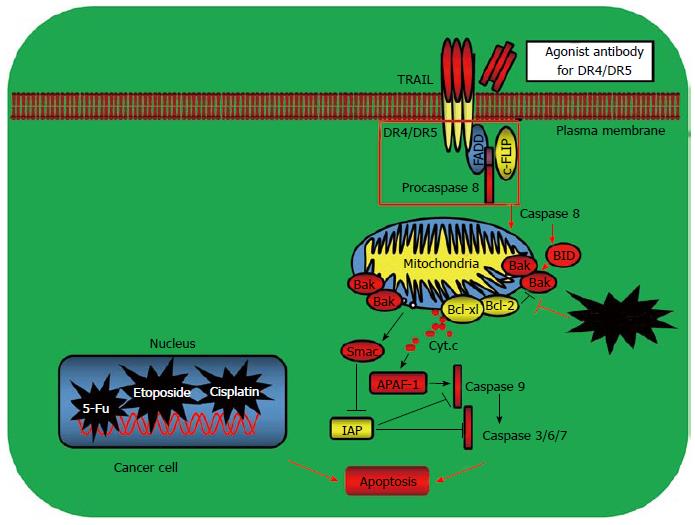Copyright
©The Author(s) 2015.
World J Transl Med. Dec 12, 2015; 4(3): 69-77
Published online Dec 12, 2015. doi: 10.5528/wjtm.v4.i3.69
Published online Dec 12, 2015. doi: 10.5528/wjtm.v4.i3.69
Figure 2 Examples of targeting apoptosis for cancer therapy.
The prominent examples for tumor targeted therapy include the approaches by targeting the tumor necrosis factor receptor family death receptor-mediated apoptotic pathway and the mitochondrial B cell lymphoma 2 (Bcl-2) family member-mediated pathway. Activation of death receptors after binding to their ligand tumor necrosis factor related apoptosis inducing ligand (TRAIL) triggers activation of the extrinsic apoptotic pathway leading to cell death. Activation of Bax and Bak causes cytochrome c release from the mitochondrion and induces apoptosis. Bcl-2 and Bcl-XL prevent the activation of Bax and Bak and inhibit apoptosis. The mAbs targeting the TRAIL receptors have been developed and exerted significant clinical activities for some cancers such as non-small cell lung cancer (NSCLC), colon cancer, breast cancer, leukemia and prostate cancer. Small molecule BH3 mimetics activate the mitochondrial apoptotic pathway by interrupting the interaction of Bcl-2 with the proapoptotic Bax and Bak and induce apoptosis. FADD: Fas associated death domain; IAP: Inhibitor of apoptosis protein; APAF-1: Apoptotic protease activating factor-1.
- Citation: Liu XC, Gao JM, Liu S, Liu L, Wang JR, Qu XJ, Cai B, Wang SL. Targeting apoptosis is the major battle field for killing cancers. World J Transl Med 2015; 4(3): 69-77
- URL: https://www.wjgnet.com/2220-6132/full/v4/i3/69.htm
- DOI: https://dx.doi.org/10.5528/wjtm.v4.i3.69









